

Ada de Warenne. David I of Scotland. Linguistic division in Scotland in the early 12th century.
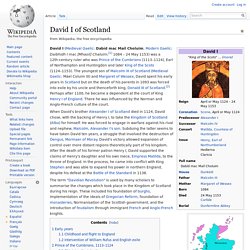
Norse-Gaelic zone, characterized by the use of both languages Cumbric may have survived in this zone; more realistically a mixture of Cumbric, Gaelic (west) and English (east) David I (Medieval Gaelic: Dabíd mac Maíl Choluim; Modern Gaelic: Daibhidh I mac [Mhaoil] Chaluim;[1] 1084 – 24 May 1153) was a 12th-century ruler who was Prince of the Cumbrians (1113–1124), Earl of Northampton and Huntingdon and later King of the Scots (1124–1153). The youngest son of Malcolm III of Scotland (Medieval Gaelic: Máel Coluim III) and Margaret of Wessex, David spent his early years in Scotland but on the death of his parents in 1093 was forced into exile by his uncle and thenceforth king, Donald III of Scotland.[2] Perhaps after 1100, he became a dependent at the court of King Henry I of England.
There he was influenced by the Norman and Anglo-French culture of the court. Early years[edit] Childhood and flight to England[edit] In England[edit] History of Scotland - King David I of Scotland. We have not space to disentangle the intricacies of David's first great domestic struggles; briefly, there was eternal dispeace caused by the Celts, headed by claimants to the throne, the MacHeths, representing the rights of Lulach, the ward of Macbeth. {20} In 1130 the Celts were defeated, and their leader, Angus, Earl of Moray, fell in fight near the North Esk in Forfarshire.
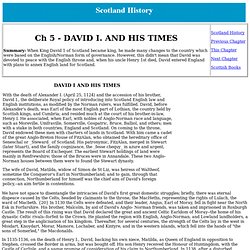
His brother, Malcolm, by aid of David's Anglo- Norman friends, was taken and imprisoned in Roxburgh Castle. Medieval and Middle Ages History Timelines - Maps of Medieval History. King David I of Scotland. David I was born circa 1080 at Dunfermline, the youngest son of Malcolm Canmore and St.
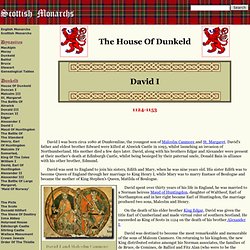
Margaret. David's father and eldest brother Edward were killed at Alnwick Castle in 1093, whilst launching an invasion of Northumberland. His mother died a few days later. David, along with his brothers Edgar and Alexander were present at their mother's death at Edinburgh Castle, whilst being besieged by their paternal uncle, Donald Bain in alliance with his other brother, Edmund. David was sent to England to join his sisters, Edith and Mary, when he was nine years old. King David I of Scotland. King David I (1084 - 1153, king from 1124) David was the youngest son of Malcolm III (Canmore) and Margaret (saint), daughter of Edward the Atheling and brother of Alexander I, whom he succeeded.
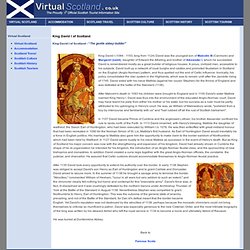
David is remembered mostly as a great builder of religious houses. A pious, civilized man, accessible to his subjects, David built up a network of royal burghs and castles and promoted feudalism in Scotland on the English (Anglo-Norman) pattern, and thus spelled out the end of Celtic influence. King David I. King David I of Scotland. Books & Posters House of Canmore Family Tree Detailed Tree English King or Queen at the Time.
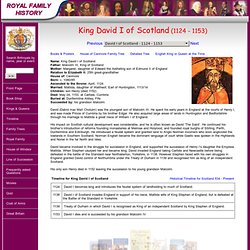
Descendants of Malcom III > David I. David I (r. 1124-1153)
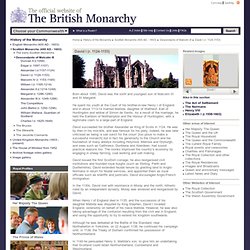
History - David I. Family of King DAVID I of Scotland (Saint David) and Countess Matilda Huntington Of NORTHUMBERLAND. King David I. King David I was brought up in the court of King Henry I of England.

He had many Norman and Flemish friends and on his succession to the the throne ceded some lands over to them. The feudal system introduced involved the Mormaers - the most powerful clan chieftains - being titled Earls, and law and order now maintained by (mainly Norman) barons or sheriffs each given a barony to administer by royal consent. This was planned to ensure the barons would provide a counterbalance to the powerful Earls. Each earldom contained many barons who could subdue an Earls influence. To stop the barons becoming too powerful their estates were small. St. David of Scotland. St.
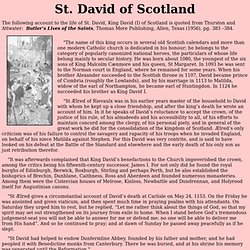
David of Scotland The following account to the life of St. David, King David (I) of Scotland is quoted from Thurston and Attwater: Butler’s Lives of the Saints, Thomas More Publishing, Allen, Texas (1956), pg. 383 –384. "The name of this king occurs in several old Scottish calendars and more than one modern Catholic church is dedicated in his honour; he belongs to the category of popularly canonized national heroes, the particulars of whose life belong mainly to secular history. The Scottish king who spent his last hours reciting the psalms. FROM THE PAST WE CAME: KING DAVID I of SCOTLAND - BATTLE OF THE STANDARD. Our gallant stand by all congest, Be this the Standard's fight, Where death or victory the test, That proved the warriors' might.
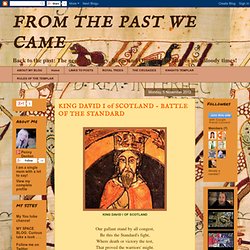
From the Chronicle of Richard of Hexham (6) In 1127 it is said in the Anglo-Saxon chronicles that King Henry I, held his court at Christmas, in Windsor. By 1135, Henry I had died. King David and the Stag - Scotland's Stories. You’ll have heard of the Palace of Holyroodhouse and the Scottish Parliament at Holyrood but do you know the legend of King David I and the Holy Rood?
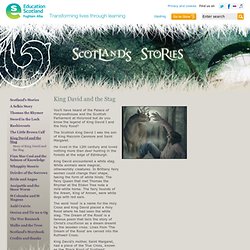
The Scottish King David I was the son of King Malcolm Canmore and Saint Margaret. He lived in the 12th century and loved nothing more than deer hunting in the forests at the edge of Edinburgh. King David encountered a white stag. White animals were magical, otherworldly creatures. In Brittany fairy women could change their shape, taking the form of white hinds. The word 'rood' is a name for the Holy Cross and King David placed a Holy Rood where he had seen the white stag. First coin issued in Scotland - a penny - sold at auction for a staggering £8,400. First coin ever issued in Scotland sells at auction for a staggering £8,400It was produced 875 years ago by Scottish King David I and found in Yorkshire in 1998 By David Baker Published: 23:28 GMT, 28 June 2012 | Updated: 09:32 GMT, 29 June 2012 The first coin ever issued in Scotland - a penny - sold at auction yesterday for a staggering £8,400.
The rare silver penny was produced in Carlisle, Cumberland, 875 years ago by the Scottish King David I after he took over the town and its mint, and his name and crest can still clearly be seen on the coin. It was discovered near Harrogate in North Yorkshire in 1998, and is one of fewer than ten known examples ever found and still in existence today. Rare: The first penny issued in Scotland sold at auction yesterday for £8,400 by London based auctioneer Spink to a private collector A bidding war at Spinks sale in London pushed the selling price way beyond its initial £2,500 estimate.